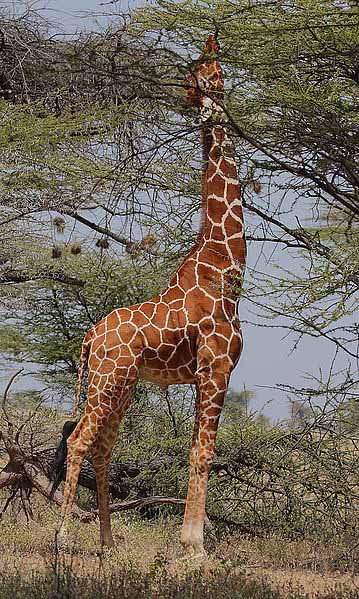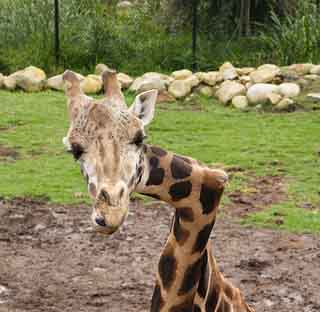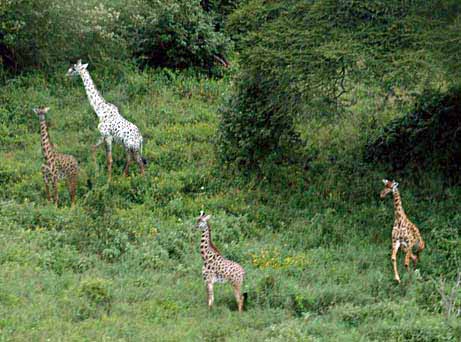Giraffe

The giraffe (Giraffa camelopardalis) is an African even-toed ungulate mammal, the tallest living terrestrial animal and the largest ruminant. Its specific name refers to its camel-like face and patches of color on a light background, which bear a vague resemblance to a leopard's spots.
The giraffe is noted for its extremely long neck and legs and unusual horns. It stands 5-6 m (16-20 ft) tall and has an average weight of 1,600 kg (3,500 lb) for males and 830 kg (1,800 lb) for females. It is classified under the family Giraffidae, along with its closest extant relative, the okapi. There are nine subspecies, which are distinguished by their coat patterns.
The giraffe's scattered range extends from Chad in the north to South Africa in the south, and from Niger in the west to Somalia in the east. Giraffes usually inhabit savannas, grasslands, and open woodlands. They prefer areas with plenty of acacia trees, which are important food sources, and can browse at heights that most other herbivores cannot reach.
While adults are nearly invulnerable to predation, lions, leopards, spotted hyenas and wild dogs prey on calves. Giraffes commonly gather in aggregations that usually disband every few hours. Males establish social hierarchies through "necking", which are combat bouts where the neck is used as a weapon. Dominant males gain mating access to females, who bear the sole responsibility for raising the young.
The giraffe has intrigued various cultures, both ancient and modern, for its peculiar appearance, and has often been featured in paintings, books and cartoons. It is classified by the International Union for Conservation of Nature (IUCN) as Least Concern, but has been extirpated from many parts of its former range, and some subspecies are classified as Endangered. Nevertheless, giraffes are still found in numerous game reserves.
Giraffe Constellation

Camelopardalis is a large but faint constellation in the northern sky. The constellation was introduced in 1612 by Petrus Plancius. Some older astronomy books give an alternative spelling of the name, Camelopardus. First attested in English in 1785, the word camelopardalis comes from the Latin and it is the romanization of the Greek meaning "giraffe", "camel", due to its having a long neck like a camel and spots like a leopard.
Symbology
The spots on a giraffe represent DNA.
Aging Male Giraffes Go Black, Not Gray Live Science - April 14, 2012

Male giraffes become more illustrious with age, but rather than the silvery locks that distinguish the likes of Sean Connery and George Clooney, the hairy blotches on these long-necked mammals darken with age. Now research suggests the appearance change takes about 1.8 years to complete, with male giraffes being completely covered in coal-black blotches by an average age of 9.4 years.

Gemina the 'crooked-necked giraffe' dies AP - January 11, 2008
Gemina, a giraffe with a distinctive crooked neck and one of the most beloved animals at the Santa Barbara Zoo, has died. She was 21. Her illness was not believed related to her neck condition. Her demise is consistent with the challenges of old age. "Though a few giraffes in captivity have been known to live into their late-twenties, reaching age 21 is considered an achievement," said zoo CEO and Director Rich Block said. "She was a great animal ambassador, showing that differences can be accepted and even celebrated. She will be missed." The giraffe was born July 16, 1986, at the San Diego Wild Animal Park and was brought to Santa Barbara when she was about a year old. She was around 3 when she began to develop a crooked neck that eventually bent sharply and made it appear that she had swallowed a hockey stick. Although her neck was X-rayed, the cause of the condition was never conclusively found. It did not affect her eating and she was treated normally by other giraffes, the zoo said. Gemina (pronounced Jeh-MEE-nah) had one offspring that died some years ago.
Not one but 'six giraffe species' Live Science - December 21, 2007
What was thought to be one species of giraffe might actually be several, scientists said today, raising concern that one or more of the species could be on the brink of extinction. A genetic study suggests there are six or more species in a region of Africa thought to have one.
Rare White Giraffe Photographed in Tanzia, Africa National Geographic - September 9, 2005

He had only a ghost of a chance, but after more than a decade of searching, a wildlife researcher has captured proof of a white giraffe. In this photo released September 6, the unusual beast and its companions stroll through a wilderness preserve in the African country of Tanzania. Charles Foley of the Wildlife Conservation Society (WCS) first heard reports of the white giraffe in Tarangire National Park in 1993. For 12 years he kept an eye out for the living legend while conducting his daily business of studying the park's savanna elephant populations.
"By 1994 the sightings stopped coming in, so I assumed it had died, either at the hand of man or beast," Foley said in a WCS press release. "I never stopped looking though."
'Giraffe of the Mesozoic' Discovered PhysOrg - September 8, 2009
A creature dubbed a "Giraffe of the Mesozoic" has been discovered in China. The animal, with its giraffe-like long neck and long forelimbs is the first well-preserved Early Cretaceous brachiosaurid dinosaur to be discovered in Asia. It lived about 100 million years ago.
Brachiosaurs were herbivorous dinosaurs belonging to the sauropod family, but in comparison to some brachiosaurs, the new species, Qiaowanlong kangxii, is quite small, at only around 10 feet tall and close to 40 feet long. It weighed a mere 10 tons.
The new brachiosaur specimen was described by authors Hai-Lu You and Da-Qing Li, in a paper published online on 4 September 2009, in the Proceedings of the Royal Society B. The brachiosaur was given the scientific name Qiaowanlong kangxii from Qiao (bridge), wan (bend in a stream), long (dragon), in reference to the area where it was found, and Kangxi, a Qing Dynasty Emperor who is supposed to have dreamt about the scenic Qiaowan region. The specimen was found in the Yujingzi Basin in Gansu Province in North West China, at an excavation site in which many other dinosaur fossils have been found in recent years, including at least three new species.
Earlier studies into sauropods suggested the animals held their necks straight out, and swung them from side to side, rather like a metal detector, but the Chinese scientists found the brachiosaur skeleton had a similar bifurcated (two-part) spine to those in other sauropods, but not previously found in brachiosaurs.
The bifurcated spine and the structure of the other bones discovered, including a unique pelvis, suggest the neck "should have been held aloft, with a more vertical than horizontal behavior," according to Hai-Lu You. Having long forelimbs and a long neck held aloft, would have made it look a little like today's giraffes, and like them, the brachiosaur would have grazed vegetation high above the reach of its competitors for food.
Sauropods were thought to have been most populous in the Jurassic in Africa and North America, but some paleontologists have theorized their population declined rapidly early in the Cretaceous period. The new finding casts doubt on this theory, since a growing number of Early Cretaceous sauropods is being discovered in China. Dr Jerry Harris, Dixie State College's Director of Paleontology, who worked with the Chinese scientists, explained that what makes the discovery so important is how it adds to our knowledge about how dinosaur populations could move around the globe in the Early Cretaceous period.
Land bridges between the continents were vanishing at this time, but as the new brachiosaur has similarities to dinosaur remains found in North America, Harris suggests some connections did still exist if only sporadically. The dinosaurs took advantage of the land bridges to move around, which explains why Chinese and American brachiosaurs appear to be closely related.

Giraffes
No comments:
Post a Comment